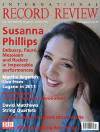Texte paru dans: / Appeared in:
*

International Record Review - (07-08/2012)
Pour
s'abonner / Subscription information
Glossa
GCD920413
8424562204133 (IDV27)
Consultez toutes les évaluations recensées pour ce cd
~~~~ Reach all the evaluations located for this CD
To my knowledge, Jordi Savall’s 1976 recording of music from De Machy’s Pièces de Violle is the only predecessor of Paolo Pandolfo’s new disc devoted exclusively to this obscure composer. Savall’s versions of Suites II and IV (with two additional movements from Suite III) demonstrated how misconceived was Robert Donington’s often-quoted judgement that De Machy’s music has no special merit. While De Machy certainly was no Marais, his pieces are full of enough lively ideas, interesting melodies and contrapuntal artifice to excite aural curiosity, even if they are intolerant of performers of less-than-superior musical intelligence and skill.
Savall’s performances were serious, even sombre, which his lugubriously resonant church acoustic emphasized. Like Savall, Pandolfo‘s technical command of his instrument is absolute. However, sitting closer to the microphone and with the advantage of both a crisper acoustic (albeit still incongruously in a church) and more transparent sound engineering, he has taken this music to a new level thanks to his good humoured performances full of flickering light and shade, agile ornamentation and, most importantly, a lively sense of dance. The intimate clarity of the recording, revealing details such as the brush of the bow across the strings, the decay of held notes and the faint rustle of Pandolfo ‘s moving hands and body, complements the music’s sense of fantasy, which blends brilliant figurations with the more subtle, coulant style fundamental to French musical taste of De Machy’s time.
Still, I have found this is one of those discs for which one really has to be in the mood. De Machy’s music does not have Marais’s ability to draw in an unsympathetic listener and over an hour of densely chordal solo viola da gamba can be a little hard going. If one is in the right frame of mind, however, it is a pleasurable and interesting recording, especially for fans of French Baroque chamber music and the bass viol.
The Pièces de Violle published in Paris in 1685 by De Machy (or ‘Demachy’, according to the title page) was the first collection of solo viola da gamba music issued in France. It preceded by only one year Marin Marais’s first book of viol music, which also originally had no basso continuo part. Like Marais, De Machy wrote for the relatively new French seven-string bass viol; but he was otherwise a traditionalist. For him, the viol’s ‘first and most ordinary’ way of being played was the jeu d’harmonie, through chords providing its own harmonies rather than relying on accompanying instruments and even playing polyphony by itself like the lute or harpsichord. Just like earlier French lute music, half the suites in the book are notated in tablature, which indicates the notes by finger position on the instrument’s fretted neck for each string rather than by their pitches. Besides genuine chords produced by double and triple stopping, the solo viol could also create the illusion of simultaneously played notes through skilful rapid alternation between notes and De Machy’s especial predilection the use of tenües (‘holds’), keeping a finger on a string to make a note continue resonating after the bow has moved to another string. De Machy identified further manner of bass viol playing in his lengthy preface to his collection: plucking, which Pandolfo has employed extensively in Suite IV, playing its entire ‘Prélude’ lute-like (including a tri any lutenist would envy) and alternating attractively between plucking and bowing in its gentle ‘Sarabande’, quirky ‘Gavotte en rondeau’ and splendidly lilting ‘Chaconne’. He also gives a delightful plucked performance of Suite V‘s tender ‘Sarabande’. Apart from providing a break from dense chordal bowing, these movements demonstrate how similar De Machy’s writing was to the French lutenists’ stile brisé, which is not so plainly evident in Savall ‘s wholly bowed performance of Suite IV.
Pandolfo‘s interesting programme notes and
the striking use of an illustration of a seventeenth-century dancer in
elaborate costume in the design of the packaging complete the production.
Fermer la fenêtre/Close window
Cliquez l'un ou l'autre
bouton pour découvrir bien d'autres critiques de CD
Click either button for many other reviews


